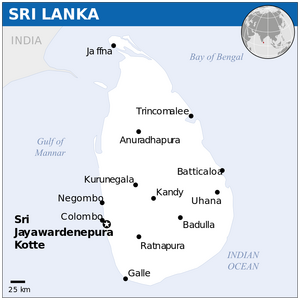Ratnapura Srilanka
| Author:Laxman Burdak, IFS (R) |


Ratnapura (Sinhala: රත්නපුර; Tamil: இரத்தினபுரி) ("City of Gems" in Sinhala and Tamil) is a major city in Sri Lanka. It is the capital city of Sabaragamuwa Province, as well as the Ratnapura District, and is a traditional centre for the Sri Lankan gem trade.
Variants
Location
Ratnapura is located on the Kalu Ganga (Black River) in south-central Sri Lanka, some 101 km southeast of the country's capital, Colombo. Ratnapura is also spelled as Rathnapura.
Ratnapura city is located in the A4 Highway which connects capital Colombo to Kalmunai in the Eastern Province. Another Highway A8 connects the town with Panadura in the western coast of Sri Lanka. In 2014, the government gave approval to the E06 Ruwanpura Expressway which will connect Rathnapura with Sri Lanka's Expressway Network.
Origin
The name 'Ratnapura' is a Sanskrit word meaning "city of gems", from the Sanskrit words pura (town) and ratna (gemstone).[1] Over 2000 years ago, when the first Buddhist monks arrived here from the north eastern provinces of India namely Bodh-Gaya, Varanasi and Pataliputra, they not only brought with them the Buddhist religion, but since their teachings were mainly in Sanskrit and Pali they also influenced the local language. While candy produced from the jaggery palm is traditionally known in this region as ratnapura, it is more likely that the candy was named for the locale rather than vice versa.[2]
Economy
It is the centre of a long-established industry of precious stone mining including rubies, sapphires, and other gems. Apart from gem mining, the city is known for the production of rice and fruit. Large plantations of tea and rubber surround the city. Tea grown in this region is called low-country tea. There is a well-established tourism industry in Ratnapura. Nearby Sinharaja Forest Reserve, Udawalawe National Park, Kitulgala, and Adam's Peak are especially popular among tourists.[3]
History
Places of worship
There are a number of places of worship in and around Ratnapura, including:
Maha Saman Devalaya – a shrine dedicated to the god Saman. The god Saman is (a Buddhist deity) considered to be the guardian of Ratnapura. When the Portuguese captured Ratnapura, the ancient shrine that stood at this location was destroyed and a Portuguese church was constructed on top of it. When the Kandyan kingdom recaptured Ratnapura, the Portuguese church was destroyed and the shrine was rebuilt. Although there is no direct evidence to support the existence of the old shrine, indirect evidence supports the existence of a shrine that looked like a Hindu temple at the current location before Portuguese times. Currently this shrine is a very important place for Buddhists.
Saints Peter and Paul's Cathedral – The history of Catholics in Ratnapura begins with Portuguese rule in Ratnapura. Very few Catholics lived in the town in the 17th century. Many of them are the descendants of Portuguese and locals that they married. There is evidence to suggest that the Portuguese built a church on top of a destroyed Buddhist temple. That Portuguese church was destroyed when the Kandyan kingdom recaptured Ratnapura from the Portuguese. The current church was built in a different location along the main street of Ratnapura (inside the town). The Church building being used now is said to be inspired by St. Joseph Vaz (Apostle of Ceylon) during the 17th century when he visited Ratnapura as a part of his apostolic mission to Sabaragamuwa. After Sabaragamuwa became a diocese on 2 November 1995 SS. Peter-Paul's Church was raised to the status of the Cathedral of the diocese.
Pothgul Viharaya - Rathnapura Pothgul Rajamaha Viharaya (පොත්ගුල් විහාරය) is a picturesque cave temple built on top of a hill believed to be built by king Vatta Gamini Abhaya better known as king Walagamba (89-77 BC) in the 1st century. It had been renovated during the days of King Kirthi Sri Rajasinghe (1747 – 1781) of the Kandy period. There are two temples belonging to these two periods within the Pothgul Viharaya.
St. Luke's Church (Church of England)
Siva Temple (Hindu)
Sri Pada (Adam's Peak): Ratnapura is the starting point for the 'classic' or hard route up Adam's Peak, via the Gilimale and Carney Estates. The pilgrimage season starts on Poya (full moon) day in December and runs until the start of the south-west monsoon in April. It has been a pilgrimage centre for over 1,000 years. King Parakramabahu and King Nissanka Malla of Polonnaruwa provided ambalamas or 'resting places' for weary pilgrims along the mountain route. The other more popular route is through Dalhousie (pronounced 'Del-house') close to Dickoya.
External links
References
- ↑ Suckling, Horatio John (1876). Ceylon: A General Description of the Island, Historical, Physical, Statistical (Volume 1). London: Chapman & Hall. p. 10. OCLC 3864935.
- ↑ Ariyaratna, D. H., President of the Sri Lanka Gem Association of the United Kingdom (2006). Gems of Sri Lanka (Sixth ed.). Colombo, Sri Lanka: D.H. Ariyaratna. p. 31. ISBN 978-955-95494-4-4.
- ↑ "Gorgeous Lanka Tours - Ratnapura". gorgeouslanka.com.

